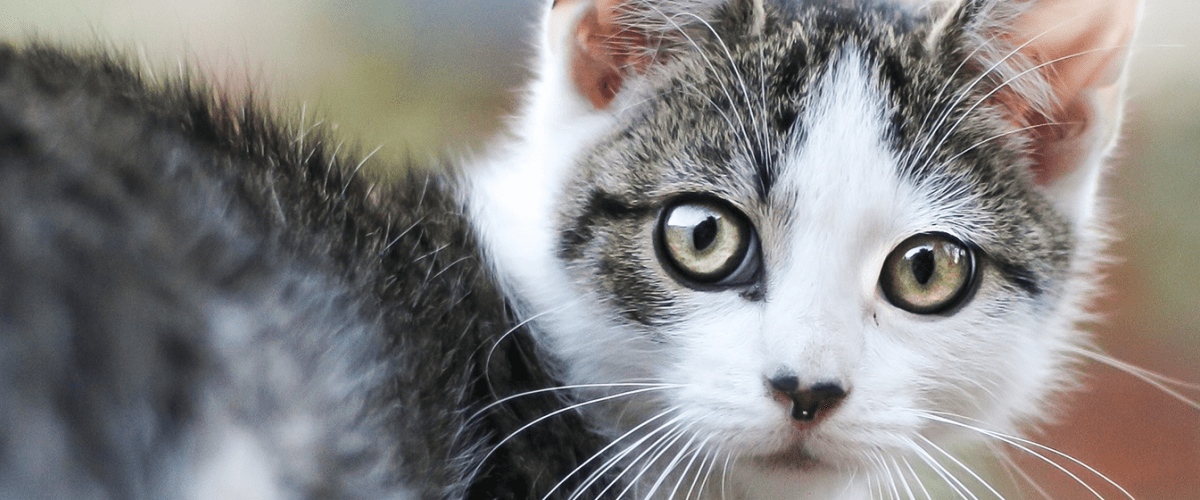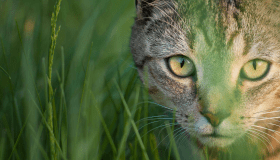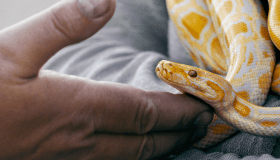
December 7, 2023 — Morris Animal Foundation is a global leader in funding research on health issues impacting all animal species – and we've been doing it for 75 years!
Each new year also brings new health issues affecting millions of animals. The good news is that animal health researchers respond with creative and innovative projects.
Here's a glimpse of five hot animal health topics we've seen emerge in 2023:
- Aging
- Antibiotic resistance
- Novel treatment strategies for disease
- Conservation genetics
- Overpopulation
Aging Pets
Thanks to better care and nutrition, pets are living longer than ever. However, that also means pets (and pet parents) are dealing with more age-related health issues, including cognitive decline, frailty and the consequences of wear and tear on the body. Aging is also a risk factor for diseases such as heart and kidney disease, diabetes and cancer.
Morris Animal Foundation is currently supporting 15 pet aging health projects, and our researchers are taking different approaches to tackle this complex health issue.
One study is looking for a possible link between toxic heavy metal exposure. Many poisonous metals can cross the blood-brain barrier in humans, accumulating in the brain tissue. This exposure increases the risk of developing age-associated diseases, including Alzheimer's disease and other dementias, as well as hearing and vision loss.
Because pets share our environment, these metals also may be associated with increased disease risk in aging dogs. The team is working with owners and their pets in cities with known moderate to high lead toxicity levels to learn more about the heavy metal burden on aging dog health. They hope their findings may provide insights into potential treatments or preventions to help protect older dogs' brain and sensory organ health and maybe help people.
Another team of researchers is asking dogs to strap on their sneakers (metaphorically, of course) to test the impacts of a customized exercise plan on frailty in aging dogs. Frailty is a widespread problem in older people and dogs and includes weight loss, weakness, exhaustion, slow walking and low activity. The team wants to learn more about how frailty changes over time and how dogs respond to their exercise program.
Many other studies focused on aging are in progress, including genetic analysis and lifespan and the role of chronic inflammation in age-related diseases. We hope these studies will bring new insight into the aging process and point to new therapies to keep our pets healthy and happy in their golden years!
Antibiotic Resistance
We rely on antibiotics to fight infections, but when overprescribed or misused, antibiotics can lead to antimicrobial resistance. Simply put, germs like bacteria and fungi can develop the ability to elude and resist drugs designed to kill them. This, in turn, leads to resistant infections or superbugs that may take longer and be more expensive to treat.
Experts point to urinary tract infections as a culprit in the escalating problem of antibiotic resistance. Recurrent UTIs require repeated antibiotic use that can easily lead to multidrug resistance. Many of our funded research teams seek solutions for this growing challenge.
In one study, our funded researchers are studying E. coli-associated UTIs, the most common type of UTI in dogs, to help inform better antibiotic use. Another group is investigating if prescribing a commonly used antibiotic for three days is as effective in treating UTIs as the currently suggested seven-day regimen. Others are running a clinical trial to evaluate a novel therapy that, if successful, could significantly reduce reliance on antibiotics to treat UTIs in pets.
Together, results from these studies will help inform veterinarians on how to use antibiotics appropriately and effectively to help resolve challenging UTIs and reduce the burden of antibiotic-resistant infections.
Hope for Fatal Diseases
While some diseases are treatable and survivable, many are not. We simply don't have effective treatments or preventives for many conditions affecting animals.
Feline infectious peritonitis and African horse sickness are two fatal diseases of particular interest to us.
Feline infectious peritonitis is caused by a deadly coronavirus specific to cats. African horse sickness is also caused by a virus and is a major global health concern. In both cases, vaccines and/or treatments would be a game-changer in the fight against these fatal diseases, potentially saving thousands of animals worldwide.
While our funded researchers did identify an antiviral that cured some cats of feline infectious peritonitis, the drug is not available in the United States, and cats continue to die from this rare but deadly virus. In a newly funded study, researchers are working on an alternate solution – designing an FIP vaccine for cats using what we now know about an mRNA vaccine design from the COVID-19 pandemic. These vaccines use microRNAs, small parts of the viral genetic code, to teach the body how to fight infection, and the team hopes the same strategy will help them develop an mRNA vaccine against FIP.
African horse sickness is causing concern globally as the disease spreads to other areas of the world. Domestic horses are highly susceptible to the virus, and outbreaks have mortality rates as high as 90%. A live vaccine is available in Africa but has safety concerns; it can trigger infection instead of preventing it. Also, no drugs or other treatments are available for horses already infected. These animals are generally euthanized to control deadly outbreaks.
Our funded researchers found that horses without a specific protein marker experience mild, nonfatal infections. Using this new information, the team is working to identify existing drugs that target this protein as a potential treatment for affected horses who carry the protein marker and are at greater risk of severe infections. An effective treatment for African horse sickness could save tens of thousands of horses from euthanasia.
Conservation Genetics
Morris Animal Foundation has a long history of funding studies to save threatened and endangered species. Previously, strategies focused on improving reproductive health and reducing infectious diseases. However, recently, the field of conservation genetics has taken center stage in the fight to save these precious animals.
Conservation genetics is not new. Using genetics to understand and reduce the risk of population decline and species extinction has been discussed for nearly half a century. However, the field of genetics has exploded in the last decade due to technological advancements.
For endangered wildlife, this means that scientists and wildlife managers in the field have better, quicker and cheaper tools to study and develop strategies to save these animals. This includes the application of genetics to identify populations of animals and species at risk of extinction, preserve the genetic variation of small, remaining populations, monitor mutations that may impact individual and group health and so much more.
The Foundation recently partnered with experts in the field of conservation genetics to fund several endangered species projects jointly. Today, our funded researchers are applying the science of conservation genetics to save black abalone off the coast of California, the Lao warty newt living in the mountain regions of Northern Laos and sea dragons living in the sea bed and rocky reefs off the shores of Australia. Together, these studies will help researchers better understand these species' current population health status and improve conservation risk assessment. Findings will also inform captive breeding and reintroduction efforts to save these animals.
Overpopulation
If there were an action we could take to save millions of cat lives, it would be to find a safe, noninvasive and cheap way to spay and neuter cats without surgery. By some estimates, 50 to 70 million free-roaming cats live in the United States alone, and that's considered a conservative estimate. If you look at cat overpopulation as a world problem, we're talking about 500 million cats or more.
Unfortunately, many free-roaming cats do not have a good quality of life. Competition for food, fighting for survival and the ever-present threat of disease impact the lives of these animals. The answer is to reduce their numbers quickly, safely and efficiently. Trap/spay/neuter programs are effective but expensive and not the solution for resource-poor communities.
This is not a new problem but is a top-funding priority and a hot topic for the Foundation. Again, thanks to advances in science, we remain hopeful that we can help find an answer to the overpopulation of free-roaming cats for a global solution. We understand free-roaming cats will always be around, but we want to improve the health and well-being of more manageable populations.
Currently, the Foundation is supporting studies trying to find nonsurgical methods to sterilize both male and female cats. We understand that we have a long way to go, but we hope that our funded research will one day help discover new ways to control cat overpopulation worldwide, improving the lives of millions of cats.
Give the gift of health to an animal you love.
Resources




